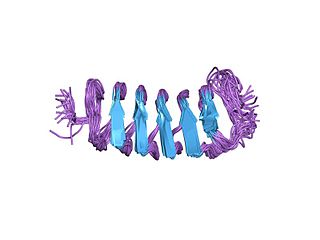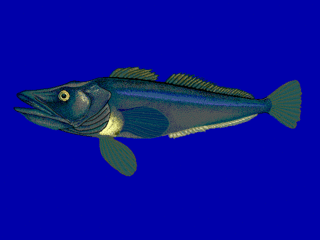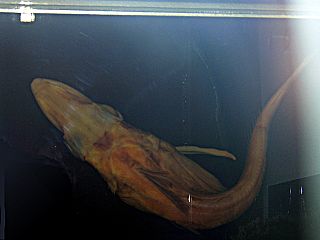Related Research Articles

The Antarctic toothfish is a large, black or brown fish found in very cold (subzero) waters of the Southern Ocean near Antarctica. It is the largest fish in the Southern Ocean, feeding on shrimp and smaller fish, and preyed on by whales, orcas, and seals. It is caught for food and marketed as Chilean sea bass together with its sister species, the more northerly Patagonian toothfish. Often mistakenly called "Antarctic cod," the Antarctic toothfish belongs to the notothen family (Nototheniidae), a group of fish species abundant near Antarctica.

Nototheniidae, the notothens or cod icefishes, is a family of ray-finned fishes, part of the suborder Notothenioidei which is traditionally placed within the order Perciformes. They are largely found in the Southern Ocean.

Antifreeze proteins (AFPs) or ice structuring proteins refer to a class of polypeptides produced by certain animals, plants, fungi and bacteria that permit their survival in temperatures below the freezing point of water. AFPs bind to small ice crystals to inhibit the growth and recrystallization of ice that would otherwise be fatal. There is also increasing evidence that AFPs interact with mammalian cell membranes to protect them from cold damage. This work suggests the involvement of AFPs in cold acclimatization.

The crocodile icefish or white-blooded fish comprise a family (Channichthyidae) of notothenioid fish found in the Southern Ocean around Antarctica. They are the only known vertebrates to lack hemoglobin in their blood as adults. Icefish populations are known to reside in the Atlantic and Indian sectors of the Southern Ocean, as well as the continental shelf waters surrounding Antarctica. Water temperatures in these regions remain relatively stable, generally ranging from −1.8 to 2 °C. One icefish, Champsocephalus esox, is distributed north of the Antarctic Polar Frontal Zone. At least 16 species of crocodile icefish are currently recognized, although eight additional species have been proposed for the icefish genus Channichthys.

The Antarctic silverfish, or Antarctic herring, is a species of marine ray-finned fish belonging to the family Nototheniidae, the notothens or cod icefishes. It is native to the Southern Ocean and the only truly pelagic fish in the waters near Antarctica. It is a keystone species in the ecosystem of the Southern Ocean.

Notothenioidei is one of 19 suborders of the order Perciformes. The group is found mainly in Antarctic and Subantarctic waters, with some species ranging north to southern Australia and southern South America. Notothenioids constitute approximately 90% of the fish biomass in the continental shelf waters surrounding Antarctica.
The Bathydraconidae, or the Antarctic dragonfishes, are a family of marine ray-finned fishes, notothenioids belonging to the Perciform suborder Notothenioidei. The family comprises four genera. These fishes are endemic to deep waters off Antarctica.
The bald notothen, also known as the bald rockcod, is a species of marine ray-finned fish belonging to the family Nototheniidae, the notothens or cod icefishes. It is native to the Southern Ocean.

Notothenia is a genus of marine ray-finned fishes belonging to the family Nototheniidae, the notothens or cod icefishes with the species in this genus often having the common name of rockcod. They are native to the Southern Ocean and other waters around Antarctica.

The blackfin icefish, also known as the Scotia Sea icefish, is a species of crocodile icefish belonging to the family Channichthyidae. The blackfin icefish belongs to Notothenioidei, a suborder of fishes that accounts for 90% of the fish fauna on the Antarctic continental shelf. Icefishes, also called white-blooded fishes, are a unique family in that they are the only known vertebrates to lack haemoglobin, making their blood oxygen carrying capacity just 10% that of other teleosts. Icefishes have translucent blood and creamy white gills.

Chaenodraco wilsoni, the spiny icefish, is a species of marine ray-finned fish belonging to the family Channichthyidae, the crocodile icefishes. It is native to the Southern Ocean. This species is the only known member of its genus. It is of minor interest to commercial fisheries.

Chionodraco is a genus of marine ray-finned fish belonging to the family Channichthyidae, the crocodile icefishes. They are found in the Southern Ocean.

Jonah's icefish is a benthopelagic species of marine ray-finned fish belonging to the family Channichthyidae, the crocodile icefishes. It is the only member of the monotypic genus Neopagetopsis. It is found in the Southern Ocean at depths of from 20 to 900 metres. It has a circum-Antarctic distribution on the continental slope and continental shelf, with the northernmost records from the South Shetland and the South Orkney Islands.

Pseudochaenichthys is a monotypic genus of marine ray-finned fish belonging to the family Channichthyidae, the crocodile icefishes. Its only member is Pseudochaenichthys georgianus, the South Georgia icefish, which is found in the Southern Ocean.

The ocellated icefish is a fish of the family Channichthyidae. It lives in the cold waters off Antarctica and is known for having transparent haemoglobin-free blood.

The wildlife of Antarctica are extremophiles, having adapted to the dryness, low temperatures, and high exposure common in Antarctica. The extreme weather of the interior contrasts to the relatively mild conditions on the Antarctic Peninsula and the subantarctic islands, which have warmer temperatures and more liquid water. Much of the ocean around the mainland is covered by sea ice. The oceans themselves are a more stable environment for life, both in the water column and on the seabed.

The emerald rockcod, also known as the emerald notothen is a species of marine ray-finned fish belonging to the family Nototheniidae, the notothens or cod icefishes. It is native to the Southern Ocean where it is a commercially important species.
Cryothenia is a genus of marine ray-finned fishes, belonging to the family Nototheniidae, the notothens or cod icefishes. They are native to the Southern Ocean.

Notothenia coriiceps, also known as the black rockcod, Antarctic yellowbelly rockcod, or Antarctic bullhead notothen, is a species of marine ray-finned fish, belonging to the family Nototheniidae, the notothens or cod icefishes. It is widely spread around the Antarctic continent. Like other Antarctic notothenioid fishes, N. coriiceps evolved in the stable, ice-cold environment of the Southern Ocean. It is not currently targeted by commercial fisheries.

Chionodraco myersi, the Myers's icefish, is a species of marine ray-finned fish belonging to the family Channichthyidae, the crocodile icefishes. It is found in the Southern Ocean.
References
- ↑ Eastman, J.T.; M.J. Lannoo (1998). "Morphology of the Brain and Sense Organs in the Snailfish Paraliparis devriesi: Neural Convergence and Sensory Compensation on the Antarctic Shelf". Journal of Morphology. 237 (3): 213–236. doi:10.1002/(sici)1097-4687(199809)237:3<213::aid-jmor2>3.0.co;2-#. PMID 9734067. S2CID 29489951.
- 1 2 3 4 5 6 7 8 Pauly; Froese; Rainer. "Family Artedidraconidae". FishBase. Retrieved 28 March 2016.
- 1 2 3 4 5 6 7 8 Froese; Rainer; Pauly. "Family Bathydraconidae". FishBase. Retrieved 28 March 2016.
- 1 2 3 4 5 6 7 8 9 Rainer; Pauly; Froese. "Family Channichthyidae". FishBase. Retrieved 28 March 2016.
- 1 2 3 4 Bailly, Nicholas; Froese; Pauly. "Species of Harpagifer". FishBase. Retrieved 28 March 2016.
- 1 2 3 4 Rainer; Froese; Pauly. "Family Nototheniidae". FishBase. Retrieved 28 March 2016.
- 1 2 Fernández, Daniel A.; Ceballos, Santiago G.; Malanga, Gabriela; Boy, Claudia C.; Vanella, Fabián A. (2012). "Buoyancy of sub-Antarctic notothenioids including the sister lineage of all other notothenioids (Bovichtidae)". Polar Biology. 35: 99–106. doi:10.1007/s00300-011-1037-7. S2CID 14252653.
- 1 2 Rutschmann, Sereina; Matschiner, Michael; Damerau, Malte; Muschick, Moritz; Lehmann, Moritz; Hanel, Reinhold; Salzburger, Walter (15 July 2011). "Parallel ecological diversification in Antarctic notothenioid fishes as evidence for adaptive radiation". Molecular Ecology. 20 (22): 4707–4721. doi:10.1111/j.1365-294X.2011.05279.x. PMID 21951675. S2CID 20019182.
- 1 2 3 4 5 6 7 8 9 10 Matschiner, Michael; Colombo, Marco; Damerau, Malte; Ceballos, Santiago; Hanel, Reinhold; Salzburger, Walter (2015). "The Adaptive Radiation of Notothenioid Fishes in the Waters of Antarctica". Extremophile Fishes. pp. 35–57. doi:10.1007/978-3-319-13362-1_3. ISBN 978-3-319-13361-4.
- 1 2 3 4 5 Evans, Clive; Hellman, Linn; Middleditch, Martin; Wojnar, Joanna; Brimble, Margaret; Devries, Arthur (2 April 2012). "Synthesis and recycling of antifreeze glycoproteins in polar fishes". Antarctic Science. 24 (3): 259–268. Bibcode:2012AntSc..24..259E. doi:10.1017/S0954102012000119. S2CID 86819542.
- 1 2 Cziko, Paul; DeVries, Arthur; Evans, Clive; Cheng, Chi-hing (7 October 2014). "Antifreeze protein-induced superheating of ice inside Antarctic notothenioid fishes inhibits melting during summer warming. Temperature". Proceedings of the National Academy of Sciences. 111 (40): 14583–8. Bibcode:2014PNAS..11114583C. doi: 10.1073/pnas.1410256111 . PMC 4209995 . PMID 25246548.
- ↑ Prisco, Guido; Eastman, Joseph; Giordano, Daniela; Parisi, Elio; Verde, Cinzia (1 May 2007). "Biogeography and adaptation of Notothenioid fish: Hemoglobin function and globin-gene evolution". Gene. 398 (1–2): 143–55. doi:10.1016/j.gene.2007.02.047. PMID 17553637.
- 1 2 Near, Thomas; Parker, Sandra; Detrich, William (26 July 2006). "A Genomic Fossil Reveals Key Steps in Hemoglobin Loss by the Antarctic Icefishes". Molecular Biology and Evolution. 23 (11): 2008–16. doi:10.1093/molbev/msl071. PMID 16870682.
- 1 2 Bargelloni, Luca; Marcato, Stefania; Patarnello, Tomaso (20 May 1998). "Antarctic fish hemoglobins: Evidence for adaptive evolution at subzero temperature". Proceedings of the National Academy of Sciences. 95 (15): 8670–8675. Bibcode:1998PNAS...95.8670B. doi: 10.1073/pnas.95.15.8670 . PMC 21134 . PMID 9671736.
- 1 2 3 4 5 6 Kock, Karl; Kellermann, Adolf (26 February 1991). "Reproduction in Antarctic notothenioid fish". Antarctic Science. 3 (2): 125–150. Bibcode:1991AntSc...3..125K. doi:10.1017/S0954102091000172. S2CID 85275970.
- 1 2 3 4 5 Near, T; Jones, C.D. (4 May 2012). "The reproductive behavior of Pogonophryne scotti confirms widespread egg-guarding parental care among Antarctic notothenioids". Journal of Fish Biology. 80 (7): 2629–2635. doi:10.1111/j.1095-8649.2012.03282.x. PMID 22650438.
- 1 2 3 Vacchi, Marino; La Mesa, Mario; Dalu, Massimo; MacDonald, John (4 May 2004). "Early life stages in the life cycle of Antarctic silver fish, Pleuragramma antarcticum in Terra Nova Bay, Ross Sea". Antarctic Science. 16 (3): 299–305. Bibcode:2004AntSc..16..299V. doi:10.1017/S0954102004002135. S2CID 128531934.
- 1 2 3 4 5 Near, Thomas; Dornburg, Alex; Harrington, Richard; Oliveira, Claudio; Pietsch, Theodore; Thacker, Christine; Satoh, Takashi; Katayama, Eri; Wainwright, Peter (2015). "Identification of the notothenioid sister lineage illuminates the biogeographic history of an Antarctic adaptive radiation". BMC Evolutionary Biology. 15: 109. doi: 10.1186/s12862-015-0362-9 . PMC 4461946 . PMID 26062690.
- 1 2 Near, T; Dornburg, A; Kuhn, K; Eastman, J; Pennington, J; Patarnello, T (2012). "Ancient climate change, antifreeze and the evolutionary diversification of Antarctic fishes". Proceedings of the National Academy of Sciences. 109 (9): 3434–3439. Bibcode:2012PNAS..109.3434N. doi: 10.1073/pnas.1115169109 . PMC 3295276 . PMID 22331888.